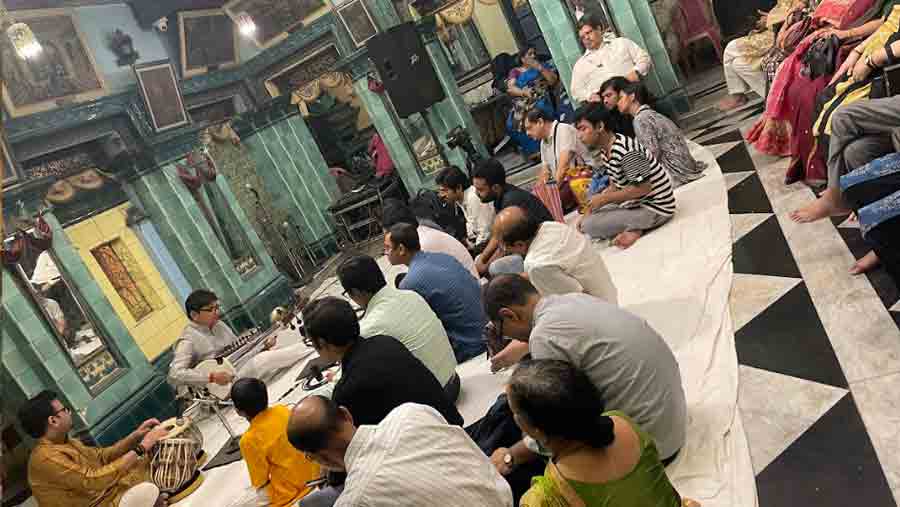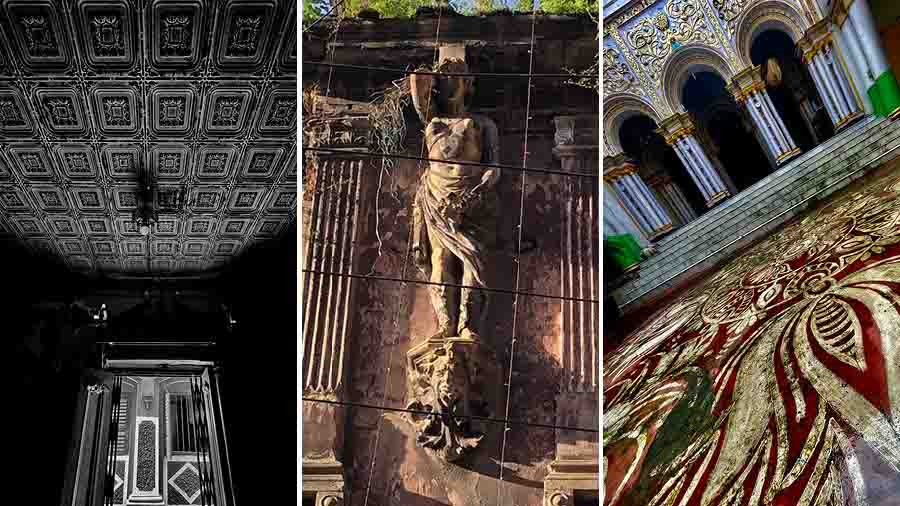Continued from here
I attended a boithak last week. There must have been a time when Calcutta comprised dozens of boithaks that have now declined to a handful, creating a case for this musical format to be classified as ‘endangered.’ The tiger is not alone.
This boithak covered the five days of Jhulan Puja at Adhikari Bhaban on Baburam Sil Lane in Bowbazar, ending August 31, 2023.
This is what made the boithak – and my experience – distinctive.
One, the boithak was not an extension of residential landlord decadence; it was presented around a sense of homage to Shyam, Radha Madhav, Nitai, Jagannath and Krishna the playful one. There was no Begum Akhtar wannabe seeking the favours of a resident Chhabi Biswas reclined on the bolsters; there was a respectful uprightness among the assembled, interspersed with a walk-in every few minutes doing pronaam to the deity and turning to find sitting space on the sprawling white gaddi. What I liked was that even though the underlying motif of the evening was devotion, it wasn’t in anyone’s face. A person like me (from a different faith) could be accommodated like every other sarod listener, making the boithak inclusive. One could actually sit inside the sanctum of the mandir – that is what it was – without feeling awkwardly conscious, and for that I have Utpal babu and his Adhikary family to thank.
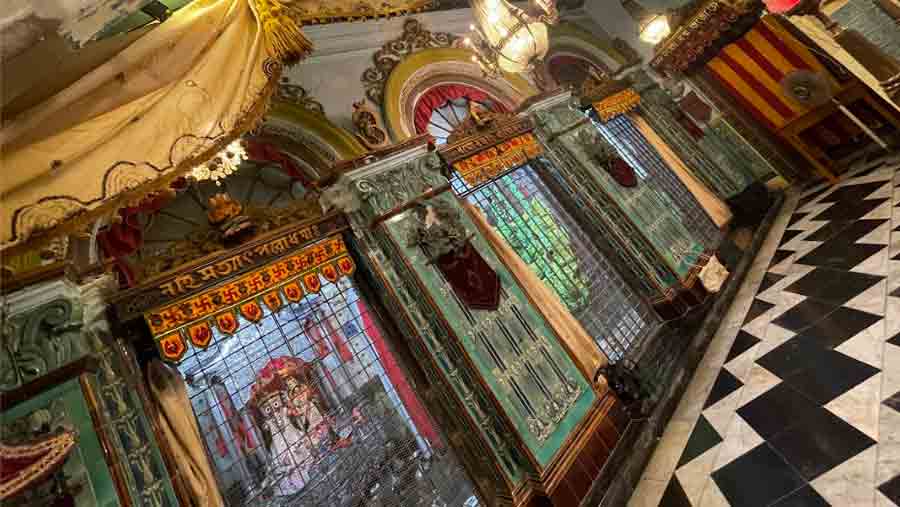
'One could actually sit inside the sanctum of the mandir – that is what it was – without feeling awkwardly conscious'
Two, there were two dimensions of the event — the real and the imagined. The real was in the there and then, with all the lights turned on and the performers in their silks in a perspiring August. The imagined was in what this place must have been like 150 to 200 years ago. So let me take a median year and pretend we are in 1850 in Adhikary Bhaban. Maharshi moshai (also known as Debendranath) has not been able to attend due to pressing commercial matters related to liabilities left by his immediately illustrious ancestor and sent word of ‘khomaa chaiichhi. The male inheritors of the Rajendra Mullick legacy turned up in their polished phaeton that stopped just outside the mandir. A trained domestic assistant lit up all the mandir lights one by one, the women of the family turned out in their silks with their sari pallu drawn tightly over their foreheads, the younger women bent to touch the feet of the older women, the older women could be identified by their skin tone (in later decades irreverent bodmaaish like me referred to this as CMYK).
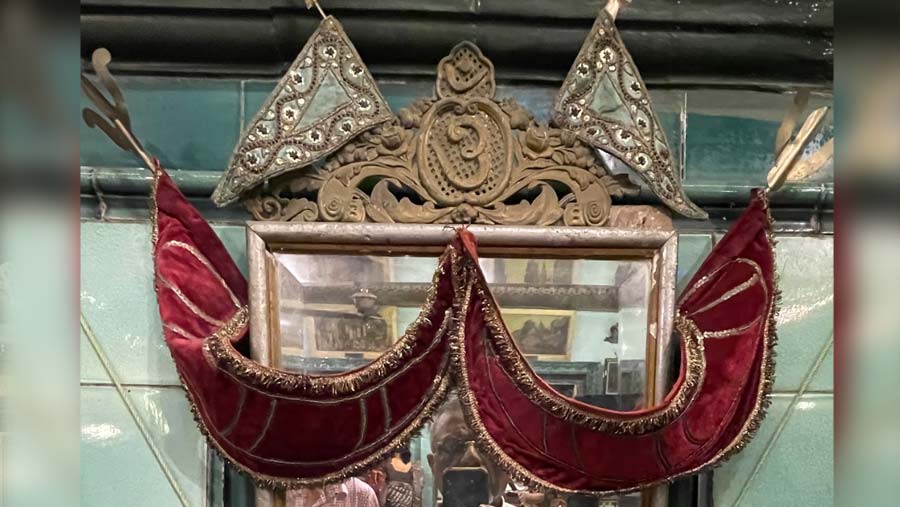
There were two dimensions of the event, the real and the imagined, and the latter takes you back over 100 years
Three, the Jhulan Pujo boithak gradually became more than a tradition. It became a social event, the kind of a latter-day Dover Lane Music Conference, important enough for some of the roshiks to assemble at Adhikary Bhaban a day after the last performance to conduct an informed post mortem: ‘Chheelo bhaalo kinto aath bochhor aageyr standard-ta touch korte parlay bhaalo hoto!’ (It was good, but would have been better if it could touch the standards of the event eight years ago.) That one line could have retarded a career by years. The post-event analysis ‘created’ a following. It was whispered that the main event was nothing; if this ‘committee’ vetoed a performer — ‘Last-er deekey shaamlatay paarlo na!’ (Couldn’t handle it towards the end) — the word got around and he was politely demoted from short-list to long list. Someone at the committee hinted of a Mymensingh sarodist having been heard of in a Sovabazar jolshaa — ‘Teen-ter por mojlish ke stombhito kore diyechhilo!’ (After three pieces, they had the gathering spellbound!). The roshiks attended to listen on five days, they converged to relive on the sixth.

The legendary Jadu Bhatt passed away at the Adhikary residence
Four, there was a time when the assembled spilled out from the sanctum onto the ante-chamber and the street. When the legendary Jadu Bhatt of the Bishnupur gharana — who trained the one and only Rabindranath Tagore — sat in the corner, he generally went into a contemplative mood, eyes closed, head down, shaking it gently and occasionally, then interrupting his trance with an approving look at the performer and then slipping into the trance again. It was adequate inducement for the performer to bow to the protima in front and thereafter a gentler obeisance to the master himself. The result was that the roshiks came from afar — when I was there last week, one of those who attended spoke of an ancestor sitting right through the night’s performances, then walking down the tramlines on Amherst Street all the way to Hatibagan to get there by sunrise. Coincidentally, Bhatt passed away at the Adhikary residence, a fact that has been carved into marble for posterity at the bhaban’s entrance.
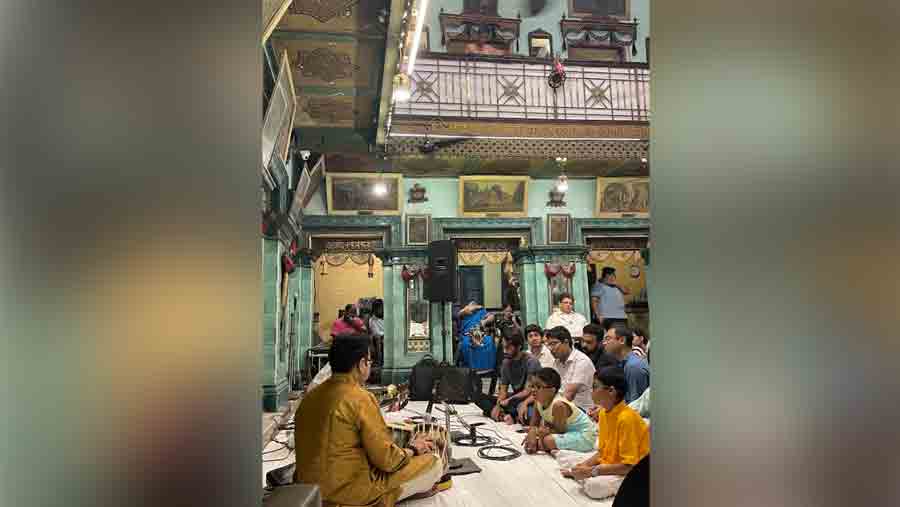
'I saw two boys, who could not have been more than ten, sitting in front, obviously foisted into the front circle with the words ‘Sheekhbi!’ (Learn!)'
Five, the resident family’s touch was evident in various micro-interventions. The century-old pennants extracted from the naphthalene balls to be hung across the sanctum. The fact that the womenfolk generally ‘managed’ the inner sanctum, which was not immediately accessible to all — segregated by a waist-high metal barricade. One family member (presumably) sat through the boithak alongside the altar. The family matriarch (my assumption, considering that she occupied the middle chair directly facing the performers) stared at each wannabe Margaret Bourke-White and when she could take it no longer, all she did was shut her eyes fleetingly coinciding with a gentle right-left that made the ‘offender’ sheepishly tuck the DSLR away and return to sarod appreciation instead.
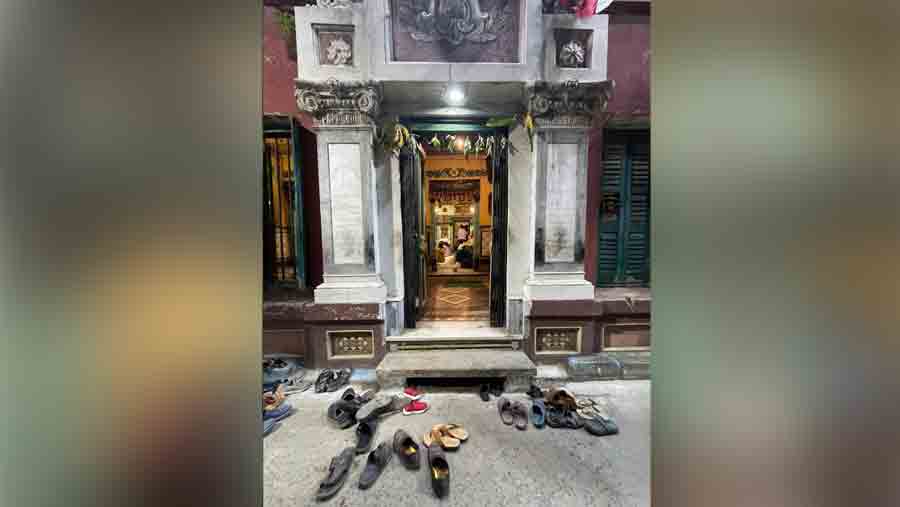
'The boithak did not comprise serious types who could decode raag Jhinjhoti backwards'
Six, the boithak represented a conscious slowing down in contrast to what one may have been doing just 15 minutes ago (swerving the automobile through Amherst Street and Shashi Bhushan Dey Street to get there). I saw a man with his eyes closed and neck turned down, one with eyes closed with the right hand cupping the mouth as if engaged in unravelling the raag, or another with eyes closed but gently tapping the left finger on the thigh (like Chhabi Biswas in Jalsaghar). The lady of the house was moving the fingers as if she were doing calculations while scribbling on an invisible blackboard like Feynman, and the person beside me interrupted what appeared to be a light reverie with an unpredictably sudden ‘Waah!’
Seven, the boithak did not comprise serious types who could decode raag Jhinjhoti backwards. I saw two boys, who could not have been more than ten, sitting in front, obviously foisted into the front circle with the words ‘Sheekhbi!’ (Learn!)
Eight, I found time to graduate from my contemplative state of mind to observe the idol of Krishna of touchstone, the Radhika statue of an eight-metal alloy and the intertwined calligraphy of Radhakrishna.
The memorable evening moment – August 30 – turned out the most ironic as well. For a good minute, the sarod was drowned out by a streetside procession shouting ‘Jeennabad! Jeennabad! Cholbe na! Cholbe na!’ while demanding immediate justice. We all turned to look towards the door; the performers permitted their fingers a moment’s unexpected relief; they smiled.
The boithak is not the only thing that has not changed at Baburam Sil Lane in Bowbazar.
